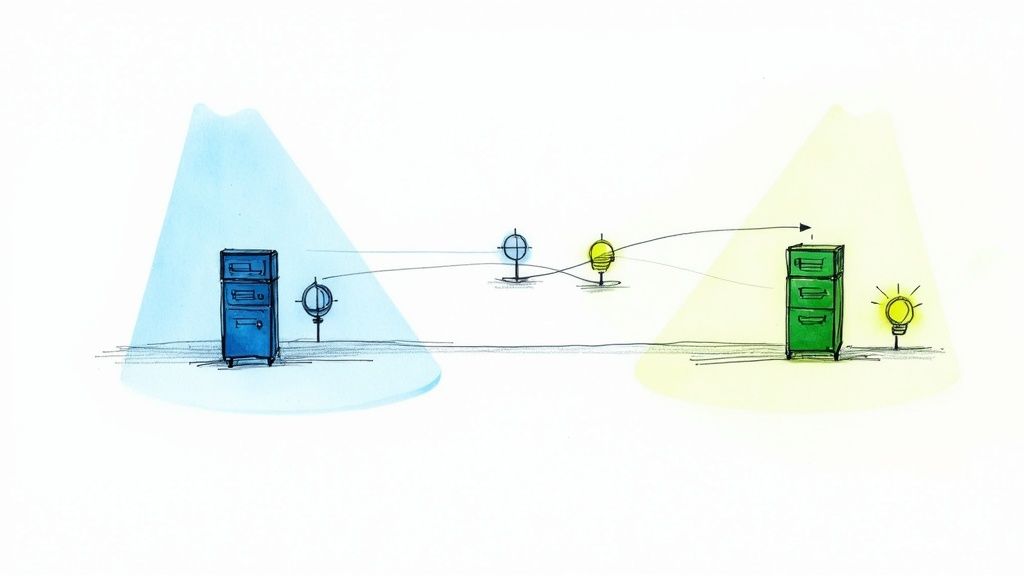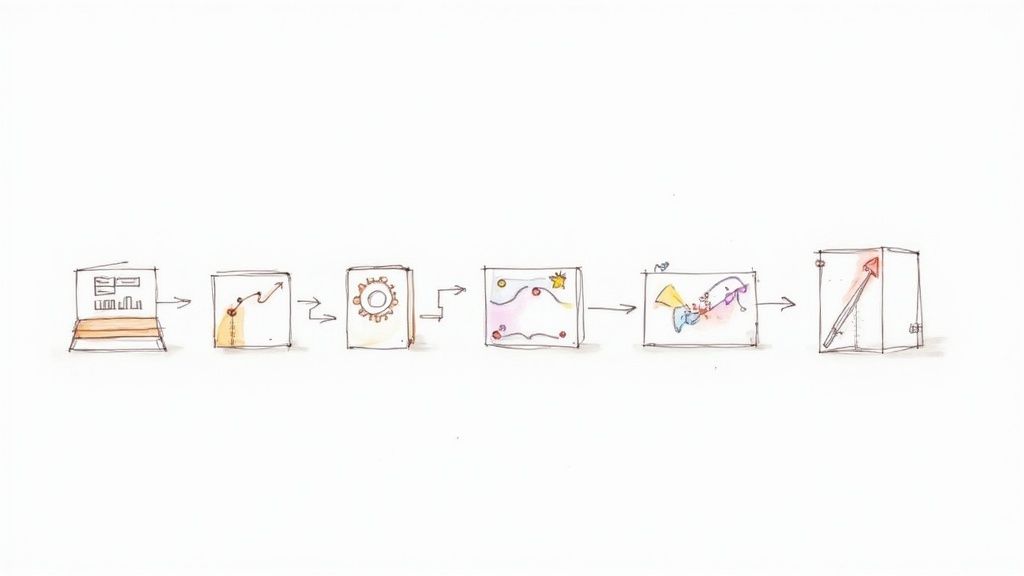Master CI CD Automation: Boost Your Dev Workflow
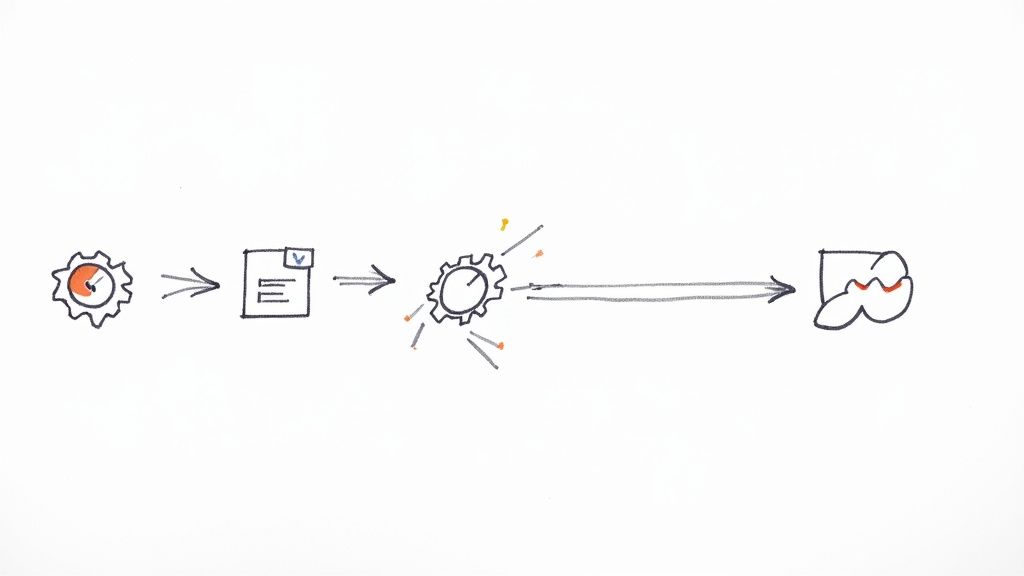
In the world of software development, CI/CD automation is the engine that powers modern DevOps. It’s what transforms a slow, manual, and often chaotic process into a fast, consistent workflow, allowing teams to release code more frequently and reliably.
What Is CI/CD Automation and Why Does It Matter?
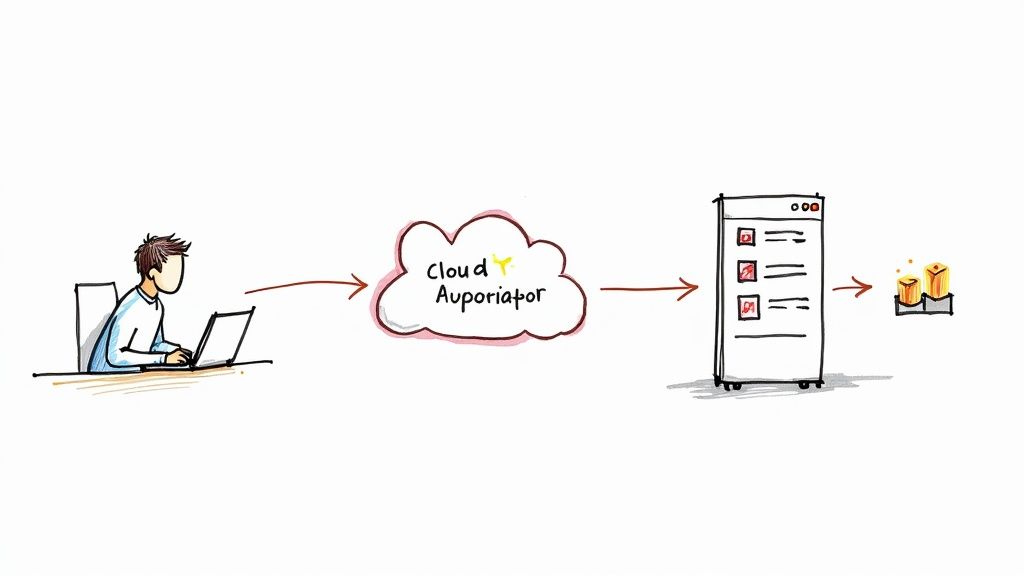
Think of your development process like a high-stakes relay race. Every developer is a runner, and each new feature or bug fix is a baton. Without a practiced system, handoffs are messy, batons get dropped, and the team loses precious momentum. CI/CD automation is that perfectly choreographed, seamless baton exchange that keeps the race moving at top speed.
At its heart, CI/CD automation is a blend of two closely related practices: Continuous Integration (CI) and Continuous Delivery/Deployment (CD). Together, they create an automated path that takes a developer's code from their local machine all the way to a live production environment with minimal human touch.
Understanding Continuous Integration
Continuous Integration is the first half of the equation. It's a development discipline where engineers frequently merge their code changes into a central repository. Every time a developer commits code, an automated process kicks off.
This process typically involves a couple of key steps:
- Building the application: Compiling the new code with the existing codebase to create a runnable version.
- Running automated tests: Executing a whole suite of tests—like unit and integration tests—to make sure the new code doesn't break anything.
The real goal of CI is to catch and squash bugs early in the development cycle when they're much easier and cheaper to fix. It’s the ultimate antidote to "merge hell," that painful situation where multiple developers’ changes clash after days or weeks of working in isolation.
The Power of Continuous Delivery and Deployment
Continuous Delivery picks up right where CI leaves off. As soon as the code is successfully built and has passed all its automated tests, it’s automatically packaged and prepared for release. The code is essentially "ready to ship" at any given moment.
In Continuous Delivery, every change that passes the automated tests is considered deployable. However, the final step of pushing it to production often requires a manual button push. This gives teams full control over when to release.
Continuous Deployment takes this one step further by automating that final deployment. If a build passes every single stage of the pipeline, it's automatically deployed to production without anyone needing to lift a finger. This is the ultimate goal for many teams looking for maximum velocity.
To get a clearer picture, let's break down how these two practices stack up.
CI vs CD: A Quick Comparison
While CI and CD work hand-in-hand, they serve different primary purposes. CI is about making sure the code is always in a healthy, integrated state, while CD is about getting that healthy code ready for release.
| Aspect | Continuous Integration (CI) | Continuous Delivery (CD) |
|---|---|---|
| Primary Goal | Verify code quality and integration | Ensure code is always releasable |
| Trigger | Code commit to a shared repository | Successful CI build |
| Key Activities | Build, unit tests, integration tests | Packaging, acceptance tests, preparing release |
| Output | A successfully tested build artifact | A deployable package ready for production |
| Frequency | Multiple times per day | As often as CI builds pass |
| End State | Code is verified and merged | Code is ready for manual deployment to production |
Understanding this distinction is key to building a robust pipeline that fits your team's needs.
The business world has certainly taken note. The global market for Continuous Delivery is a testament to its impact, valued at roughly USD 4.93 billion and projected to soar to USD 13.60 billion by 2032. This explosive growth is fueled by the relentless need for faster, more dependable software deployment in a cutthroat market. You can dig into the numbers and trends on the continuous delivery market's growth on coherentmi.com.
Ultimately, CI/CD automation isn't just some technical jargon; it's a strategic philosophy. It empowers organizations to deliver real value to customers faster and more reliably than ever before. It marks a shift away from risky, infrequent "big bang" releases toward small, manageable updates that slash risk and supercharge innovation.
The Real Business Impact of CI CD Automation
While the technical side of CI/CD is impressive, its real power is what it does for the business itself. Thinking of CI/CD automation as just an IT upgrade is missing the point. It’s a strategic move that directly touches your bottom line, your place in the market, and your ability to innovate. It’s how you turn developer efficiency into a real corporate advantage.
The main promise of CI/CD is, simply, speed. By automating everything from a code commit to a customer release, you shrink development cycles from months or weeks down to just days or even hours. This kind of agility means you can react to market shifts, launch new features, and squash bugs at an incredible pace. One of the clearest business wins is its proven role in accelerating time to market, letting you out-maneuver slower competitors.
Boosting Developer Productivity and Innovation
Your development team is one of your biggest assets, but they often get bogged down by repetitive, low-value work—manual builds, testing, and deployment coordination. This isn’t just inefficient; it’s a killer for morale and creativity.
CI/CD automation frees your developers from that grind. Instead of babysitting deployments, they can focus their brainpower on what they're truly great at: solving tough problems and building the innovative features that push the business forward. This shift creates a more engaged, productive engineering team, and that’s a powerful edge to have.
According to Google's DORA research, organizations with faster code reviews—a key element of a healthy CI/CD process—demonstrate 50% greater software delivery performance. This data highlights the direct link between streamlined development workflows and tangible business results.
This isn’t just about getting more work done. It’s about getting more meaningful work done. When developers are free to experiment and innovate, they build better products that customers love and that open up new sources of revenue.
Reducing Costs and Mitigating Risk
The old way of shipping software—the "big bang" deployment—is a recipe for disaster. When you cram months of changes into a single update, you create a high-stakes event where one bug can take down the whole system. The result? Costly downtime and a damaged reputation.
CI/CD completely changes this dynamic by encouraging small, frequent, and incremental updates. This approach dramatically lowers the risk of each release.
- Early Bug Detection: Automated tests run on every single commit, catching bugs almost as soon as they’re written. Fixing a bug at this stage is exponentially cheaper than finding it weeks later in production.
- Faster Recovery: When a problem does pop up in a small release, it's far easier to pinpoint the cause and roll back that specific change, minimizing the impact on users.
- Improved Code Quality: The pipeline has continuous feedback loops and automated quality checks built right in, ensuring a higher standard of code from the get-go. For more on this, check out our guide on continuous integration best practices.
This massive risk reduction has a direct financial payoff. By preventing expensive outages and cutting down the time spent fixing bugs, CI CD automation frees up resources that can be put back into growth. It transforms your development process from a source of potential chaos into a reliable, predictable engine for moving the business forward. Ultimately, it helps you build a more resilient, efficient, and forward-thinking organization.
Anatomy of a High-Performing CI/CD Pipeline
Think of a modern CI/CD pipeline as the automated assembly line for your software. It’s a structured, stage-by-stage journey that takes a developer's fresh code commit and turns it into a live feature for your customers. To really get CI/CD automation, you need to see how this assembly line works from start to finish.
So, let's pull back the curtain and walk through the core stages that define a high-performing pipeline: Build, Test, and Deploy. Each stage has a specific job, and they all work together to make sure code is shipped quickly, safely, and reliably.
This infographic breaks down the fundamental flow, from building the code to checking its quality and, finally, getting it into the hands of users.
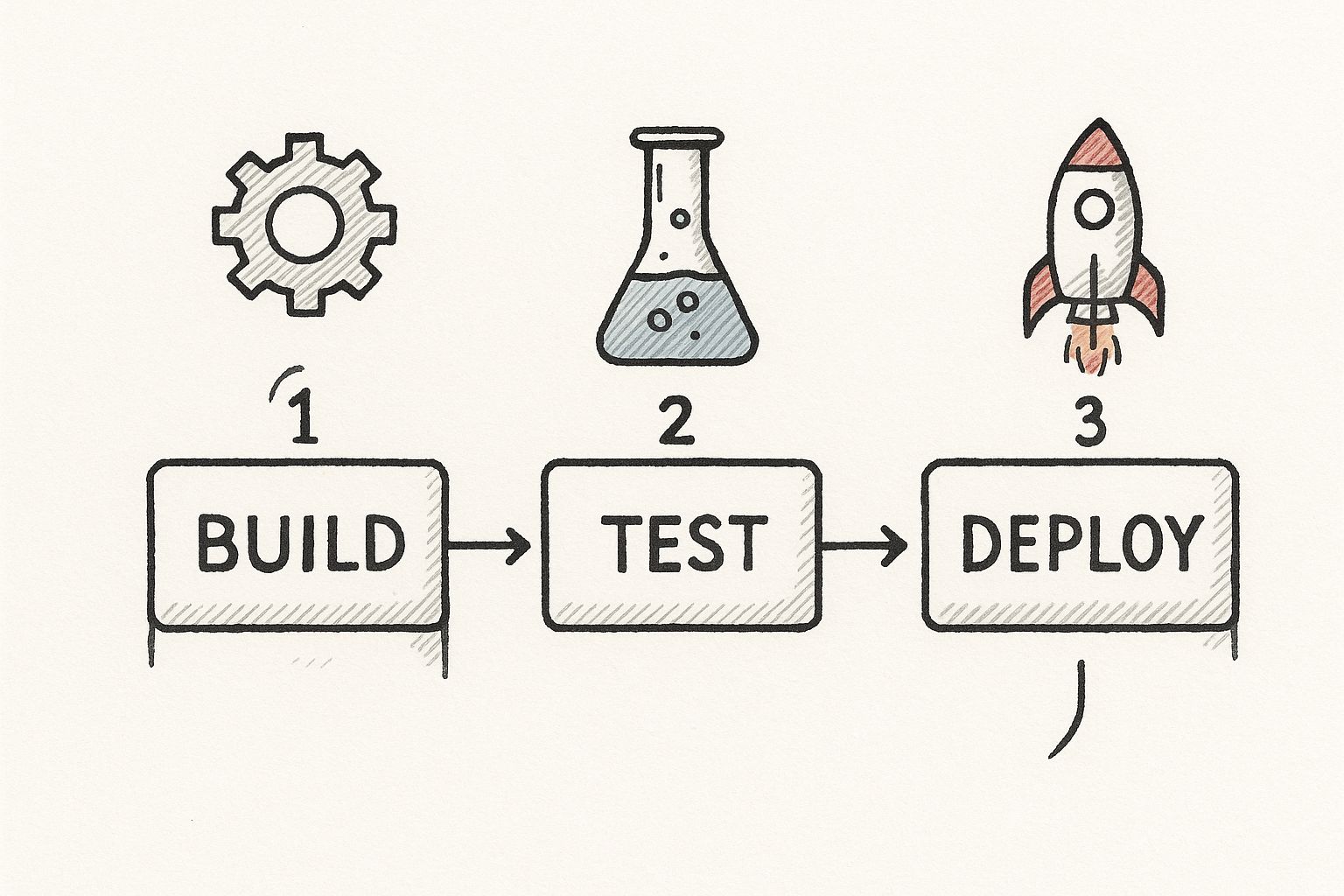
As you can see, it's a linear progression. Each stage acts as a gatekeeper for the next, ensuring only quality code gets to move forward.
The Build Stage: Where Code Becomes an Artifact
The whole process kicks off the moment a developer commits new code to a version control system like Git. That single action is the trigger for the first stage of the pipeline: the Build stage.
This is like gathering all the raw ingredients for a recipe. The CI server grabs the latest code change, pulls in any necessary dependencies, and compiles everything into a single, runnable package. We call this a build artifact—it might be a Docker container, a JAR file, or another type of executable.
A non-negotiable rule here is to build the package only once. This exact artifact is what gets passed through every single stage that follows. This discipline guarantees that the code you test is the exact same code you eventually deploy, which helps you avoid those nasty "but it worked on my machine!" surprises. A successful build is the first green light, telling you the new code plays nicely with the existing codebase.
The Test Stage: The Gauntlet of Quality Assurance
Once the build artifact is ready, it enters the most critical phase for quality: the Test stage. Here, the artifact is thrown into a gauntlet of automated tests designed to catch any bugs, regressions, or security flaws before they ever see the light of day.
A mature pipeline doesn't just run one type of test. It uses a multi-layered strategy:
- Unit Tests: These are your first line of defense. They’re small, fast tests that check individual pieces of code, like a single function, to make sure they work in isolation.
- Integration Tests: After the unit tests pass, these tests make sure different parts of the application work together as intended. They check the handoffs between various modules and services.
- Acceptance Tests: These are higher-level tests that validate if the software meets business requirements and works correctly from a user’s point of view.
The real goal of this stage is to get feedback, fast. If any test fails, the pipeline stops dead in its tracks, and the development team gets notified immediately. This "fail fast" approach prevents a broken build from getting any further, saving a ton of time and resources down the line.
The tools that run this stage are big business. The market for Continuous Integration (CI) tools, which handle the build and test stages, was valued at $2.37 billion in 2024 and is projected to hit $6.48 billion by 2029. That growth really drives home how critical automated testing has become for modern software development.
The Deploy Stage: Releasing to Production
After an artifact has survived the testing gauntlet and passed every check, it's officially declared ready for production. The final stage, Deploy, is where the new code finally gets released to your users. The amount of automation here is what really separates Continuous Delivery from Continuous Deployment.
High-performing teams don't just dump the new code into production all at once. They use smart deployment strategies to minimize risk:
- Blue-Green Deployment: You maintain two identical production environments. The new code is deployed to the inactive one (the "green" environment), and once it's verified, you simply switch the traffic over. It's a clean, instant rollback if something goes wrong.
- Canary Release: The new version is rolled out to a small group of users first. The team monitors its performance closely. If everything looks good, the rollout continues until everyone has the new version.
Tools like Jenkins are foundational for managing these kinds of complex deployment workflows. If you want to dive deeper into how it fits into this puzzle, check out our detailed guide on CI/CD with Jenkins. Understanding these stages gives you a clear map of how an idea becomes reality in a modern, automated world.
Choosing Your CI CD Automation Toolkit
Once you have a solid picture of what a CI/CD pipeline looks like, the next obvious question is: what should I use to build it? The market for CI CD automation is packed with options, and it’s easy to feel a bit lost. But here's the secret: it's not about finding the single "best" tool. It's about finding the right tool for your team's workflow, your tech stack, and where you see your project heading.
Making that choice starts with understanding the two fundamental types of CI/CD tools. This decision is a major fork in the road and will shape everything from cost and maintenance to how well your setup scales.
Self-Hosted vs. Cloud-Based Solutions
First things first: do you want to manage the infrastructure yourself or let someone else handle it?
- Self-Hosted Tools (e.g., Jenkins): This is the DIY approach. You install, configure, and manage tools like Jenkins on your own servers. The big advantage here is total control. You can tweak every last detail to meet strict security or compliance rules. The trade-off? That control comes with a hefty maintenance burden. Your team is on the hook for every update, security patch, and scaling challenge.
- Cloud-Based Tools (e.g., GitHub Actions, GitLab CI/CD, CircleCI): With SaaS platforms like GitHub Actions, GitLab CI/CD, or CircleCI, the provider handles the infrastructure for you. You just define your pipeline, and their servers run it. This massively cuts down on maintenance, freeing up your team to do what they do best—build software, not babysit CI servers. You give up a bit of that fine-grained control, but for most teams, it’s a worthy exchange.
Today, the sheer convenience and scalability of cloud-based solutions make them the go-to choice for most teams. It just makes sense to reclaim that valuable engineering time.
Key Questions to Ask When Evaluating Tools
After you've picked a path, you can start digging into specific tools. Don't just jump on the latest trend. Instead, run each option through a filter of what your team actually needs.
Here are the critical questions to ask:
- Does it integrate with our existing tech stack? Your CI/CD tool has to play nice with your version control system (like GitHub or Bitbucket), container registries, and cloud providers. If it doesn't, you'll be stuck with manual workarounds, which completely defeats the purpose of automation.
- How steep is the learning curve? Some tools are incredibly powerful but notoriously complex to set up. Others feel more natural to developers, often using simple YAML configurations. Think about how much time your team can realistically spend learning the ropes.
- Can it scale as we grow? The tool you pick today needs to handle your ambitions for tomorrow. Will it choke on more complex pipelines, more parallel jobs, or a growing team? You need something that scales smoothly.
- What does the community and support look like? A vibrant community means you'll find plenty of documentation, plugins, and answers to common problems on forums. If you're an enterprise, you'll also want to look closely at the quality of paid support.
Ultimately, the "best" tool is the one that empowers your team without becoming another system to manage. It should feel like a natural extension of your workflow, automating tasks in a way that is both powerful and intuitive.
Investment in this space is exploding. The global Continuous Delivery market hit USD 4.27 billion in 2024 and is on track to reach USD 17.80 billion by 2034. That's a clear signal that the industry is all-in on automation. For a deeper dive into these numbers, you can find more Continuous Delivery market research on precedenceresearch.com.
As you piece together your pipeline, looking at a broad range of DevOps automation tools will help you assemble the most effective toolkit. This careful selection process is what ensures your CI CD automation is built on a solid, sustainable foundation.
Proven Best Practices for CI/CD Implementation
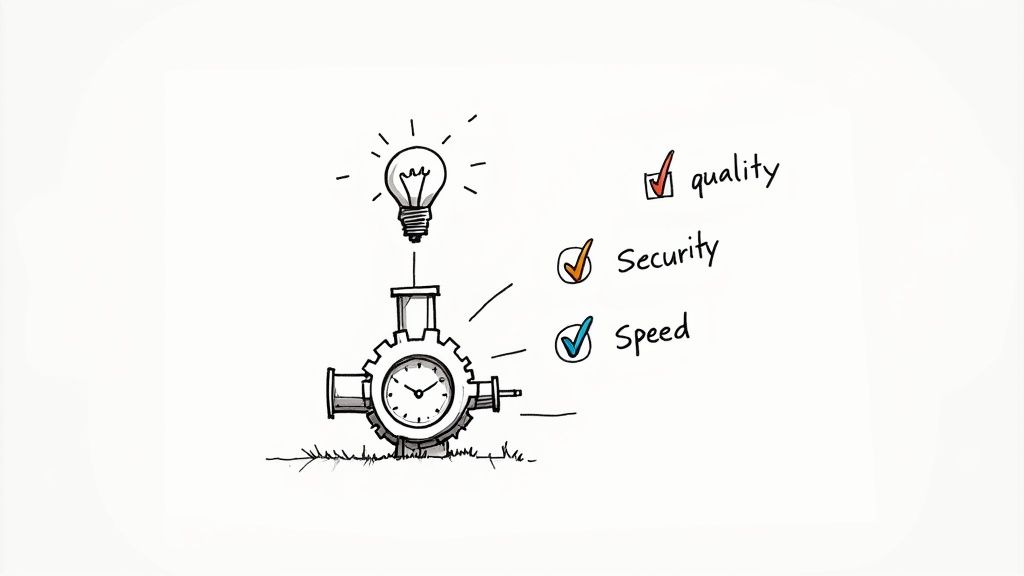
A great CI/CD pipeline is so much more than a collection of tools wired together. It’s a living, breathing reflection of strong engineering principles. When you adopt CI/CD automation, you're really embracing a set of practices that can transform a fragile, manual process into a resilient and secure engine for delivering software.
These strategies are what separate a pipeline that just works from one that gives you a real competitive edge.
Let's start with one of the most foundational principles: treat your pipeline as code. Instead of clicking through a web UI to set up jobs and stages, you define the entire pipeline in a configuration file (like a YAML file) that lives right alongside your application code. This is a game-changer.
This approach, often called Pipeline-as-Code, makes your pipeline versionable, reviewable, and reproducible. Anyone on the team can propose changes through a pull request, and new projects can easily spin up using proven templates. It’s all about consistency and collaboration.
Prioritize Fast Feedback Loops
Let's be honest: the whole point of automation is to get feedback to developers fast. A pipeline that takes an hour to report a simple syntax error is a pipeline that developers will quickly learn to ignore. You have to be aggressive about optimizing for speed.
This means running the fastest tests first. Lightweight unit tests and static analysis should kick off the moment a commit is pushed. The longer, more intensive integration or end-to-end tests can run in parallel or a bit later in the process. It's a "fail fast" mentality that ensures developers aren't stuck waiting for a build that was doomed from the start.
According to research from Google's DORA team, elite-performing teams have a lead time for changes of less than one hour. Achieving that kind of speed is flat-out impossible without rapid, automated feedback at every single step.
A fast, reliable feedback loop builds trust in the automation. That trust encourages developers to commit small, frequent changes—which is the very cornerstone of effective CI/CD.
Shift Security Left with DevSecOps
In the old days, security was often a last-minute checkpoint right before a release. This created a massive bottleneck and a lot of friction. Modern CI/CD automation flips that on its head with a "shift left" approach, baking security into every stage of the pipeline. We call this practice DevSecOps.
Instead of a frantic, last-minute scramble, security becomes a continuous, automated habit.
- Static Application Security Testing (SAST): These tools scan your source code for vulnerabilities the second it’s committed.
- Software Composition Analysis (SCA): This automatically checks your open-source dependencies for any known security holes.
- Dynamic Application Security Testing (DAST): This runs tests against your live application in a staging environment to spot runtime security flaws.
By building these checks directly into the pipeline, you catch security issues early when they are far easier and cheaper to fix. For a deeper look, our article on CI/CD pipeline best practices explores this and other key strategies in much more detail.
Maintain a Single Source of Truth
Your version control system—almost always Git—has to be the undisputed source of truth for everything. I'm not just talking about your application code. This includes your infrastructure definitions (Infrastructure-as-Code), your pipeline configurations (Pipeline-as-Code), and all your test scripts.
If it’s going to be deployed, it must come from a commit in your central repository. Period.
This discipline gives you complete traceability. When a bug pops up in production, you can trace it back to the exact code commit, the specific pipeline run that deployed it, and the tests that were executed against it. This level of transparency is essential for debugging, auditing, and maintaining a stable system. It kills ambiguity and ensures every change is intentional and logged, forming the true backbone of a reliable delivery process.
Getting CI/CD automation right is a game-changer, but the road to get there is rarely a straight shot. Plenty of teams, excited to get started, run headlong into predictable traps. These stumbles can turn what should be a source of strength into a daily frustration.
Knowing what these common pitfalls are ahead of time is half the battle.
One of the most corrosive problems you'll encounter is the dreaded flaky test. These are the tests that pass one minute and fail the next, even when the code hasn't changed. They're often caused by weird timing issues or an unstable testing environment. At first, they just seem like a minor annoyance.
But over time, they slowly poison your team’s trust in the entire system. When developers can no longer believe a red build actually means something is wrong, they start to ignore notifications. The whole feedback loop, the very reason you built the pipeline, just breaks down into noise.
Battling Overly Complex Pipelines
Another classic misstep is building a pipeline that tries to do too much, too soon. It’s tempting to throw in every possible check and deployment strategy right from the start. But this usually leads to a tangled, monolithic beast that's a nightmare to understand, maintain, and debug.
When this "all-in-one" pipeline inevitably fails, it can bring all development to a screeching halt while someone spends hours trying to figure out what went wrong. The smarter move? Start simple. Add complexity only when you need it.
Your pipeline should be treated like any other piece of software. It needs to be clear, modular, and refactored over time. If only one person on your team understands how it works, you haven't built an asset; you've created a liability.
This philosophy keeps your CI/CD automation from becoming a brittle mess, allowing it to adapt as your project grows.
Forgetting the Human Element
Maybe the biggest pitfall isn't technical at all. Implementing CI/CD is as much about changing your team's culture as it is about installing tools. You can have the most perfectly engineered pipeline in the world, but if your team isn't on board with the new way of working, it's doomed to fail.
This cultural shift boils down to a few key things:
- Embracing collective ownership: The pipeline isn’t just for the DevOps team; it belongs to everyone. Developers need to feel empowered to jump in and fix it.
- Committing small and often: Teams used to massive, long-lived feature branches have to get comfortable with smaller, more frequent commits to the main branch.
- Valuing fast feedback: A broken build should be an "all hands on deck" situation. The whole team needs to prioritize fixing it to keep the assembly line moving.
Solutions for a Resilient Pipeline
So how do you dodge these bullets? You need a proactive game plan. Keeping your pipeline healthy and trusted has to be an active effort.
- Quarantine Flaky Tests: Don't just delete them. Move them to a separate, non-blocking test run. This way, they won't stop deployments, but you can still analyze and fix them without derailing the main pipeline.
- Keep It Modular: Break your pipeline into smaller, independent stages. This not only makes it easier to run things in parallel for more speed but also dramatically simplifies troubleshooting when something breaks.
- Invest in Observability: You monitor your application, right? You need to monitor your pipeline, too. Tools like Mergify's CI Insights give you a clear view into your pipeline's performance, helping you spot bottlenecks and infrastructure hiccups before they become chronic problems.
By getting ahead of these challenges, your team can build a culture of continuous improvement around your CI/CD process. This is how you make sure your automation truly becomes an engine for delivering value, not just another complex system to manage.
Got Questions About CI/CD?
Even when the pipeline concept feels solid, specific questions always pop up. It's completely normal. Let's tackle some of the most common ones I hear from teams who are just getting started or looking to refine their automation strategy.
Delivery vs. Deployment: What's the Difference?
This is easily one of the most frequent points of confusion, but the distinction is pretty straightforward once you get it.
Think of Continuous Delivery as having a fully packaged and approved product sitting in the warehouse, ready to ship at a moment's notice. The final "ship it" decision is manual. In contrast, Continuous Deployment automates that final step, shipping the product the instant it's ready without any human intervention.
So, with Continuous Delivery, every change is releasable, but a human has to push the button to send it to production. Continuous Deployment, on the other hand, automatically deploys every single build that passes all the checks. The right choice really boils down to your team's business needs and how much risk you're comfortable with.
How Does CI/CD Actually Improve Software Quality?
CI/CD automation has a massive impact on software quality because it creates an incredibly tight feedback loop. When automated tests run against every single code change—not just once a day or once a week—bugs and integration issues get caught almost instantly.
This means developers can fix problems while they're still small, simple, and cheap to address. It stops them from festering for weeks, only to be discovered later in a staging environment or, even worse, by your customers. That constant, immediate validation is the secret to building more reliable software, piece by piece.
Is CI/CD Only for Big Companies?
Absolutely not. In fact, you could argue that small teams and startups have even more to gain from CI/CD automation. It acts as a powerful force multiplier, letting a small team punch well above its weight and compete with much larger organizations.
By automating all the tedious manual processes, you free up your developers to focus on what matters: building great features. It dramatically reduces operational overhead, allowing you to get features and fixes out the door faster and more reliably—a critical advantage when you need to be nimble and responsive to the market.
Ready to stop wrestling with your CI pipeline and start shipping faster? Mergify provides the tools you need—like our automated Merge Queue and CI Insights—to eliminate bottlenecks, cut costs, and empower your developers. Discover how Mergify can transform your workflow today.




